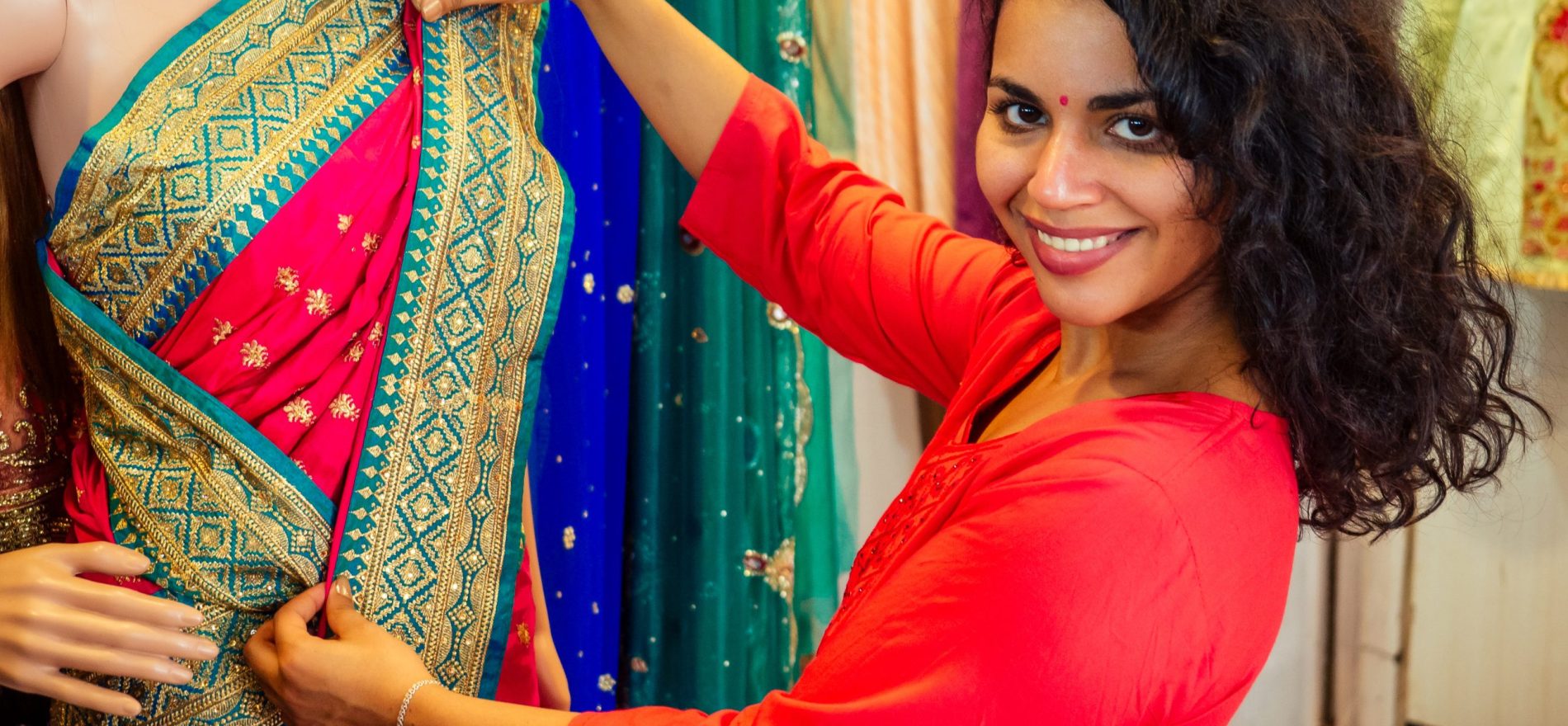The history of fashion in India is impossible, to sum up in a few words since artisans and designers were able to capture the ethnicity, elegance, and grandeur of each era. What fascinates the minds of the inquiring is the tweaking-turning evolution of the same. An outline of the development, history and types of fashion designing courses in India is provided here as per the fashion history timeline.
One of the biggest contributors to the economy of capital goods is the textile sector in India. Indian fashion is renowned for its traditional, cultural, and ethnic touches. Even today, when Indian design climbs to new heights on the world stage, it is impossible to overlook the country’s fashion evolution. The Indian fashion business has experienced both significant and minor changes. Explore India’s fashion history! Uncover cultural influences and iconic trends. Dive into the vibrant industry. Discover the journey in this article.
Table of Contents
- The Origin
- Indian Textile VS Indian Fashion
- Indian Fashion During Colonialism
- Indian Fashion: Post Independence
- The Bollywood Turn
- History of Fashion Illustration
- Want to Know More About the Rise of Design
- FAQ
The Origin
The Indus Valley Civilization is said to be the origin of everything. The Bronze Age of Civilization, also known as the Indus Valley Civilization, which spanned from 3300 BCE to 1300 BCE, is when the earliest records of traditional Indian dress were discovered.
Did You Know?
The art of the Mauryan Empire (322–187 BCE) has the first documentation of the draping of a cloth like a saree. The sculptures from that era may be seen wearing sarees and adorned with intricate jewellery carvings.
Indian Textile VS Indian Fashion
Long before the fashion industry ever started to make its first moves, the Indian textile sector was growing. Long before the time of colonialism, India had begun exporting cotton and silk. Around 300 BCE, India learned how to make silk from the Chinese. Many locations across India became become hubs for silk weaving. These were mostly locations like Delhi, Cochin, Gujarat, and Varanasi. Silk swiftly gained popularity among the nation’s royals because of its softness and opulent feel.
With the expansion of the Mughal Empire, elaborate about fashion designing and patterns on silk started to appear. But clothing was a luxury enjoyed exclusively by the wealthy. The wealthy also donned jewellery, lehengas, and sherwanis that had been expertly embellished, in addition to lovely silk clothing.
Indian Fashion During Colonialism
The skirts, trousers, and blouses of the anglosphere were introduced to India by the East India Company. The British employees were required to adhere to these styles while working as clerks in their workplaces. The upper classes then gradually started to adopt these European styles.
Before Indian colonization, fashion was a luxury enjoyed exclusively by the wealthiest citizens of the nation. The influence of the caste system on Indian design history is something worth noticing. The activity of the populace and the usefulness of the garment dictated fashion. Poor farmworkers and office workers, for instance, dressed in dhotis and cotton sarees, but soldiers and warriors donned armor. Clothing served as a representation of caste, status, and the many responsibilities that people played in society.
The people themselves frequently fashioned and weaved these cotton clothes by hand. The majority of the population did not perceive a need for or demand for trendy attire.
Although most middle-class Indians were required to wear fashion at the time, the industry did not thrive even during the colonial era. This was significantly influenced by poverty and tyranny.
Indian Fashion: Post Independence
Years after India’s independence, the economy still appeared to be suffering from the detrimental effects of colonialism. Once more, fashion took a backseat to the economy as the nation continued to experience economic hardship. However, the country’s urban and educated people favored western dress, which helped to some part preserve European design.
Only when the country’s stable economy and the partition came into play did the Indian fashion industry truly begin to flourish. Inter-state trade growth also contributed to the emergence of Indo-Western fashion.
The Bollywood Turn
Bollywood has had the most influence on the Indian fashion industry. People began to be significantly inspired by the dress style of Bollywood stars as color film gained popularity in the 1950s. Its culture, as well as the British to some extent, served as inspiration for films.
The 1940s to 1960s
For sartorial inspiration, people looked up to stars like Dilip Kumar and Dev Anand as well as actresses like Madhubala and Nargis Datt. The Indian fashion industry suffered from a lack of organization and restricted apparel styles as a result of the scarcity of bazaars and affordable brands.
The 1980s to 1990s
The Bollywood era’s 1980s and 1990s accomplished a remarkable job of increasing fashion’s appeal to the general public. Once again, people drew inspiration from celebrities like Amitabh Bachchan, Jackie Shroff, and Zeenat Aman whose fashion said volumes about their personalities.
With the debut of denim, bell bottoms, and even sportswear, many 1970s styles were also on par with European fashion.
The Economic Rise of the 1980s
Homegrown companies entered the mainstream for the first time in the history of fashion in India. Brands like Lakme, Louis Phillipe, and Park Avenue became well-known among Indian consumers.
Finally, Indians were able to make a living off of fashion design in the 1980s. The renowned names Abu Jani, Sandeep Khosla, and Tarun Tahilani were among the earliest Indian fashion designers, and their creations are still well-liked by their clientele. There was more rivalry in the fashion business as other labels began to emerge. The history of Western fashion also started in India as international brands soon began to enter India, and boutiques gained prominence and were friendlier to the younger generation.
NIFT was the first organization to offer fashion education. More fashion progress has occurred in the last two decades than in any previous time period, and films like Maine Pyaar Kyun Kiya gained popularity for the actors’ style and attire choices.
The 1990s to 2000s
As more individuals began watching TV, fashion spread throughout all Indian families. The Indian fashion sector has benefited greatly from exposure to fashion publications. Manish Malhotra and Rohit Bal were two of the era’s most well-known designers, and people still recognize and value their work today.
As a result of Sushmita Sen and Aishwarya Rai winning beauty pageants, this era was significantly affected by worldwide beauty standards. Traveling overseas also grew more popular, which increased the impact of western dress styles.
Internet connection was simple, and women’s discretionary income increased in the 2000s. As more women gained financial independence, they were able to spend more money on clothing and cosmetics. More global companies have already begun expanding their bases into India, including Louis Vuitton and H&M.
The 2010s to 2020s
An increasing number of individuals with smartphones are now able to purchase more effortlessly and conveniently thanks to digital advancements, improvements, and a booming economy. Since the rise of e-commerce, more individuals than ever before are making purchases online.
In recent decades, India’s fashion industry has seen a number of turbulent upheavals. Every style is now easily accessible because of the internet age. Fashion is now accessible and simple. Brands must, however, take into account the constantly shifting preferences of their consumers, particularly in India, where quality has recently been regarded to be more important than anything else in clothes.
Fashion Now
The 1980s in particular were a major source of inspiration for present fashion trends like the oversized boyfriend blazer. Yellow and blue are going to be prominent fashion colors in the coming decade. However, several trends from the latter part of the 2010s could potentially continue to be in vogue towards the start of 2023.
The privileged in society have always set fashion trends. They were initially established by the royal family, who would set models for others to imitate. The ones who determine fashion trends today are celebrities and influencers. However, in the end, it is up to you to determine what you deem to be stylish and leave your stamp on fashion history. The history of fashion technology also plays a huge role in the development of the fashion industry in India.
History of Fashion Illustration
The history of fashion illustration dates back about 500 years. There has always been a desire to convey a concept or vision in a visual representation, even before there was clothing. Fashion drawings serve as both a kind of art and a way to illustrate or create a garment. The bulk of fashion illustrations were made to be viewed up close, necessitating a keen eye for detail on the part of the illustrator. According to [who?], fashion illustration is a visual luxury.
Since Vogue started using photographs instead of its renowned drawn covers in the late 1930s, there has been a fall in fashion illustration. This was a significant turning point for the fashion business. According to Laird Borrelli, the author of Fashion Illustration.
Want to Know More About the Rise of Fashion in India?
A year-long program called the Diploma in Fashion Design offers real-world exposure to the fashion sector which will prepare you for the industry even before you enter it.
Join AAFT Online: You will study several well-known fashion designer’s works in this one-year Diploma in Fashion Design course as well as the basic principles of fashion design.
One has to master this art in order to be a competent fashion designer. With the aid of necessary tools and best business practices, this curriculum educates young managers, professionals, and entrepreneurs to handle a variety of responsibilities in the fashion sector. This program will also help you understand the history of fashion design in-depth as the course has fashion history classes.
FAQs
What is the historical origin of fashion in India?
India’s fashion history started with the handcrafted textiles used by people in ancient civilizations such as the Indus Valley. Various regional patterns developed over centuries, blending Mughal, British, and contemporary design influences with traditional fabrics.
How did the Indian textile industry evolve before modern fashion?
The Indian textile industry prospered prior to modern fashion to manual or traditional weaving, natural colors, and regional workmanship. Long before industrialization shaped modern fashion, India was an essential international part of the industry because of methods like silk weaving, embroidery, and block printing.
What changes occurred in Indian fashion during the colonial period?
Indian fashion began integrating Western and conventional patterns throughout the colonial era. Wearing sarees and dhotis with jackets, shirts, and pants started in this era. New textiles, tailoring techniques, and contemporary fashion concepts were also brought to India by British influence.
How did Indian fashion develop after independence?
Post independence, India started to represent contemporary values and ethnic pride. In order to create a unique indo-western style, designers began to combine traditional sewing, handlooms, and weaves with modern shapes.
What role has Bollywood played in shaping fashion trends in India?
One of the biggest influences that the Indian scene experienced was by Bollywood. From historic sarees to elegant designs today, move celebrities have influenced generations with new styles on and off television.
How did fashion in India change during the 1940s to 1960s?
During the 1940s–60s, Indian fashion evolved from colonial influences to embracing national identity. Sarees, Nehru jackets, and khadi garments became popular symbols of pride, while cinema introduced modern cuts and elegant, timeless looks.
Related Courses

Fashion Design

Fashion Styling

Diploma In Art of Makeup

Diploma in Interior Design




















